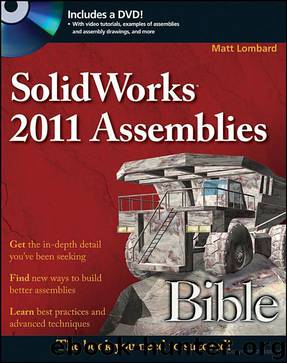SolidWorks 2011 Assemblies Bible by Matt Lombard

Author:Matt Lombard
Language: eng
Format: mobi, epub
ISBN: 9781118002766
Publisher: Wiley
Published: 2011-05-16T00:00:00+00:00
Working with Derived Sketches in Assemblies
Derived sketches are a very powerful, but surprisingly underused, feature. They enable you to use a parametric copy of a sketch in another feature. When you edit and change the original sketch, the Derived Sketch updates immediately. The derived sketch becomes like a sketch block in that you can't change it, but you can position, orient, and even mirror it as you need, on any plane in the part without regard to the derived sketch's relationship to the original sketch's orientation.
Derived sketches enable you to create any kind of feature you can create with normal sketches, so you should not have problems using them with extrudes, lofts, sweeps, and so on. Remember that if you are just trying to copy a sketch to use the copy in the exact location of the original, you may be able to simply reuse the sketch. Some features such as curves do not allow you to reuse their parent sketches, but others such as extrudes, revolves, and lofts do.
In addition to being used within a part, derived sketches can also be used in context, in an assembly. For example, you can use a parametric copy of a sketch from Part 1 in Part 2 within a given assembly.
To create a derived sketch, select a sketch from the FeatureManager, and then Ctrl+click a plane or planar face and select Insert⇒Derived Sketch. This command places you in a copy of the sketch where you cannot change dimensions, relations, or add or remove sketch entities.
The best tool for moving the derived sketch is the Modify Sketch tool. You can only add relations or dimensions to the derived sketch that will locate the sketch as if it were a static sketch block. Remember that the sketch can rotate as well as translate. If one corner of a derived sketch is locked down, the rest of the sketch can rotate around that point.
When you create a derived sketch, it appears in the FeatureManager, as shown in Figure 12.4.
FIGURE 12.4
Derived sketches are identified in the FeatureManager.
Download
SolidWorks 2011 Assemblies Bible by Matt Lombard.epub
This site does not store any files on its server. We only index and link to content provided by other sites. Please contact the content providers to delete copyright contents if any and email us, we'll remove relevant links or contents immediately.
Kathy Andrews Collection by Kathy Andrews(11763)
The remains of the day by Kazuo Ishiguro(8887)
Paper Towns by Green John(5136)
Spare by Prince Harry The Duke of Sussex(5134)
The Body: A Guide for Occupants by Bill Bryson(5026)
Industrial Automation from Scratch: A hands-on guide to using sensors, actuators, PLCs, HMIs, and SCADA to automate industrial processes by Olushola Akande(5024)
Machine Learning at Scale with H2O by Gregory Keys | David Whiting(4257)
Be in a Treehouse by Pete Nelson(3996)
Never by Ken Follett(3876)
Harry Potter and the Goblet Of Fire by J.K. Rowling(3805)
Goodbye Paradise(3760)
Into Thin Air by Jon Krakauer(3346)
The Remains of the Day by Kazuo Ishiguro(3342)
Fairy Tale by Stephen King(3306)
The Cellar by Natasha Preston(3295)
The Genius of Japanese Carpentry by Azby Brown(3254)
120 Days of Sodom by Marquis de Sade(3223)
The Man Who Died Twice by Richard Osman(3039)
Drawing Shortcuts: Developing Quick Drawing Skills Using Today's Technology by Leggitt Jim(3036)
